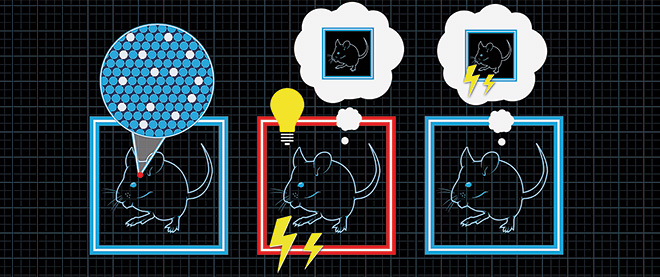‘Project Inception’ plants false memories in the minds of mice
The good, the bad and the fake in the brains of rodents
Collective Next
Share

In the 1950s, Canadian neurosurgeon Dr. Wilder Penfield found that activating certain parts of the brain would elicit specific memories.
Building on that famous work, a team at the Massachusetts Institute of Technology (MIT) has planted false memory in the minds of mice. “We called it Project Inception,” says graduate student Steve Ramirez, who was lead author on the paper (published in the journal Science in July) with Xu Liu. As the name suggests, Ramirez is a science fiction fan: Inception was the 2010 blockbuster in which characters devise a way to enter the subconscious mind, and plant an idea there.
Working in the lab of Susumu Tonegawa, an investigator at MIT’s Howard Hughes Medical Institute, Ramirez and his collaborators engineered brain cells in mice that make a light-sensitive protein when certain neurons are activated, enabling them to “find single memories at the level of brain cells and reactivate them,” Ramirez explains.
By tricking these cells to react to a pulse of light, “we were able to elicit the recall of the memory.” That was two years ago. In this latest paper, they took a neutral memory and turned it into a fearful one. (Fear is an easy emotion for scientists to identify, which makes it ideal for the study: When mice are afraid, they run to a corner and stay frozen in place.)
Mice were exposed to unique cages, each with its own smells, lighting and floor. As the mice checked out the surroundings in the first cage, certain neurons in their brains were activated, producing the light-sensitive protein. As they explored the second cage, scientists used light to switch on the neurons that were activated in the first cage, while shocking their feet. The mice then went back into the first cage—where nothing had shocked them—and were now afraid. They spent more than one-quarter of their time frozen.
No memory is written in stone. “It’s constantly being modified, updated and, sometimes, it’s a false memory,” Ramirez says. “This shows that in animals, we can specifically induce the process.” It also teaches us about the basic mechanisms involved in creating memories, including false ones. To achieve their result, scientists had to mash two memories together; in the future, they might be able to create entirely new memories, bringing us a step closer to the world of Inception.